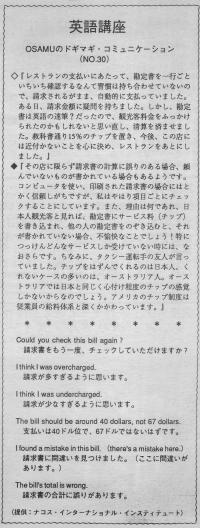請求書に誤りがあります。
Osamu paid his restaurant bill without looking at it over carefully. He was not used to checking to see if he was charged correctly. One day, he had some doubt about the bill but the handwriting was illegible. He thought that they added an addtional fee for tourists but left 15% tip just like the guide book told him to. He decided not to go to that restaurant again. When foreigners go to restaurants, sometimes it is presumed that they don't know how to give tips. So it is sometimes added to the bill. That is why it is important for visitors to read the bill before they pay it because you could be paying the tip twice. On the bill, it's usually called a "service charge." If you don't know if you should pay tip, you can ask these questions: "Was a service charge added to the bill?" ( or another way to say it:) "Did you add a service charge (to the bill)?" Another word for "tip" is gratuity. You can use this in a sentence also. Example: "Was the gratuity included in the bill?"
レストランの支払いにあたって、勘定書を一行ごといちいち確認するなんて習慣は持ち合わせていないので、請求されるがまま、自動的に支払っていました。ある日、請求金額に疑問を持ちました。しかし、勘定書は英語の達筆(?)だったので、観光客料金をふっかけられたのかもしれないと思い直し、清算を済ませました。教科書通り15%のチップを置き、今後、この店には近付かないことを心に決め、レストランをあとにしました。
その店に限らず請求書の計算に誤りのある場合、頼んでいないものが書かれている場合もあるようです。コンピューターを使い、印刷された請求書の場合にはとかく信頼しがちですが、私はやはり項目ごとにチェックすることにしています。
また、理由は何であれ、日本人観光客と見れば、勘定書にサービス料(チップ)を書き込まれ、他の人の勘定書をのぞき込むと、それが書かれていない場合、不愉快なことでしょう!特につっけんどんなサービスしか受けていない時には、なおさらです。
ちなみに、タクシー運転手の友人が言っていました。チップをはずんでくれるのは日本人、くれないケースの多いのは、オーストラリア人。オーストラリアでは日本と同じく心付け程度のチップの感覚しかないからでしょう。アメリカのチップ制度は従業員の給料体系と深くかかわっています。
請求書をもう一度、チェックして頂けますか。
Could you check this bill agian?
請求が多過ぎるように思います。
I think I was overcharged.
請求が少な過ぎるように思います。
I think I was undercharged.
支払いは40ドル位で、67ドルではないはずです。
The bill should be around 40 dollars, not 67 dollars.
請求書に間違いを見つけました。
(ここに間違いがあります。)
I found a mistake in this bill. (There’s a mistake here.)
請求書の合計に誤りがあります。
The bill’s total is wrong.


